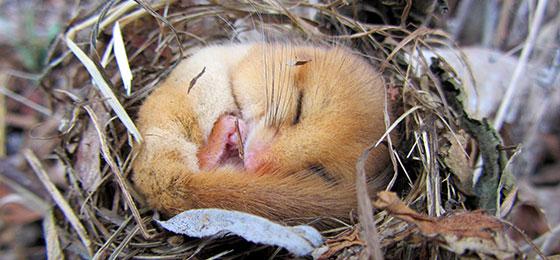Dormice may have hibernated as early as 34 million years ago

In analysing rodent fossils, scientists funded by the Swiss National Science Foundation have come up with a novel hypothesis: hibernation was a survival strategy 34 million years ago.
Until very recently, the ability to hibernate was thought to have appeared during the Quaternary ice age 2.6 million years ago. Now, a study funded by the Swiss National Science Foundation (SNSF) suggests that the process may have been present much earlier in some mammals. The results have been published in the Journal of Systematic Paleontology (*).
Olivier Maridet is curator at the Jurassica Museum in Porrentruy and a palaeontologist at the University of Fribourg. Maridet and his team have been interested in the evolutionary history of the Gliridae family – small rodents with bushy tails, including the edible dormouse, the garden dormouse and the hazel dormouse. In looking at the species richness of this family over time in relation to climatic changes, the researchers discovered that the family diversified three times and that each episode coincided with an ice age. “These rodents clearly had some advantage that enabled them to prosper during these times”, says Maridet. “We hypothesise that it was hibernation.”
An archaic defect turned to advantage
Some rodent fossils suggest that hibernation was an established strategy 2.6 million years ago – their incisors show seasonal interruptions in growth. It is thought that this ability to hibernate emerged and spread in response to the difficult survival conditions at the time, which corresponds to the beginning of the Quaternary ice age – the current geological period. In their study, however, Maridet and his colleagues suggest that hibernation may already have been a feature of the Gliridae 34 million years ago. “It could in fact be an archaic trait preserved in some species up to the present and lost in others which developed different strategies to survive”, says Maridet.
The research team became interested in Gliridae as part of their research on the Eocene to Oligocene transition, a period which saw the major turnover of terrestrial fauna known as the “Grande Coupure” in Europe. It coincided with a significant period of cooling that led to the formation of the Antarctic ice cap and lowering of sea levels, facilitating the passage of animal species between continents. In Europe, mammals underwent a major disruption during this time. Many of them, such as the Adapidae primates, paleotheres (distant cousins of today’s horses) and certain groups of rodents indigenous to Europe, disappeared; others, more modern and originating in Asia, became established, including hamsters, beavers, rhinoceroses, pigs and tapirs. The Gliridae managed to survive the crisis and even diversified. “After the Cretaceous–Tertiary extinction, which among other things witnessed the disappearance of the dinosaurs, this event is among those that had the greatest impact on ecosystems over the last 65 million years”, says Maridet.
The story of the Gliridae, told by their teeth
In carrying out their study, the researchers used more than 500 teeth of Gliridae fossils from France and Spain. The team analysed the size and shape of the teeth according to 124 different criteria to determine the degree of kinship between species. The researchers also scanned several teeth using x-ray tomography to gain as much information as possible, including their internal structure. The teeth spoke volumes. For the first time, it has been possible to draw the complete evolutionary tree of the Gliridae family –complete in the sense that the tree takes into account not only current species but also fossil species. The study confirmed the affinities between extant species that had previously been suggested based on molecular analyses. The detailed study of the anatomy of the Gliridae teeth also showed that the current classification of this family could do with a little dusting off.
(*) X.-Y. Lu, L. Costeur, M. Hugueney, O. Maridet: New data on early Oligocene dormice (Rodentia, Gliridae) from southern Europe: phylogeny and diversification of the family. Journal of Systematic Paleontology (2021).https://doi.org/
.
Contact
Supporting research in all disciplines
This work was supported by the SNSF’s project funding scheme. Following a selection procedure, the scheme enables researchers to independently conduct research projects with topics and goals of their own choice.
Links
- Download image for editorial use, (JPEG)Legend: Dormice were probably hibernating as long as 34 million years ago.
© Zoë Helene Kindermann, CC BY-SA 4.0 - The project in P3, the SNSF’s research database